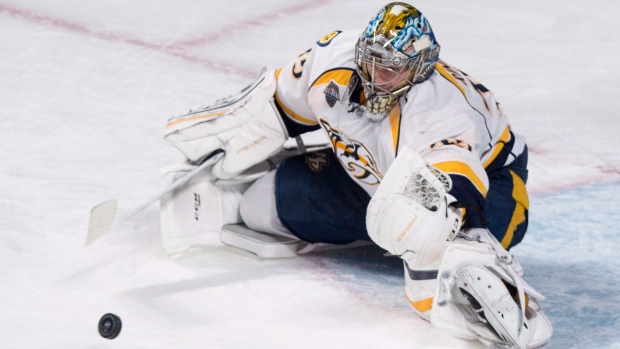Jul 12, 2016
Predators yet to address the Rinne question
The P.K. Subban trade might have given the Nashville Predators the best defence in the entire NHL, but goaltending remains an issue, Travis Yost writes
By Travis Yost

One of the interesting wrinkles of the blockbuster P.K. Subban and Shea Weber swap is the difference in playing styles between the two blueliners, and the trickle-down effect they will have on their teammates.
I’m of the opinion that Nashville won this deal in rather decisive fashion, namely because they checked all three boxes: better player, younger player and the more team-friendly contract situation (perhaps more specifically, a contract that expires before the 2026 season). With Subban, an already impressive pool of blueline talent and a pair of interesting depth options in Yannick Weber and Matt Irwin, I think you can make the case that Nashville has the best defence in the entire NHL. And that may be true by a considerable margin.
That said, one of the things that’s kind of been glossed over this summer is the fact that the Predators really haven’t resolved an increasingly unstable goaltending situation. Remember, this is a Predators team that was good to great most nights at 5-on-5, finishing top-5 in pure shot differential last season. For all of that work, they finished with 96 points – a respectable enough number to get into the postseason, but a number I think the organization privately feels they could beat going forward.
I think they’re right. Because despite a crop of competent two-way forwards and the talented defensive corps, Nashville still conceded a league average number of goals. That might be good enough to get into the playoff conversation, but it’s not good enough when you are talking about bona fide Stanley Cup contenders.
Goaltending was the piece acting as a drag on Nashville on the goals-against front. Despite their fantastic shot differentials, bottom-third goaltending – 90.5 per cent save percentage in all situations, and 92.2 per cent at 5-on-5 – kept Nashville from really making that leap forward. And this takes into account the very strong 17 games Carter Hutton put together for the Predators in relief duty.
In other words: Pekka Rinne, who played 66 games last year for the Predators as the team's highest paid player, struggled.
The thing is, last year’s up-and-mostly-down season for Rinne wasn’t totally unexpected or surprising. Outside of an excellent 2010 season, Rinne has both underwhelmed relative to his peers, and underwhelmed relative to what we would’ve expected a normal goaltender to stop in the same environment in Nashville. To show the latter, we’ll use the expected goal methodology at Corsica, which takes into account shot types, distances, angles, and rebound/counterattacking chances.
Here’s how Rinne fares over the last six seasons:
You can look at this one of two ways. First, the more straightforward methodology: Rinne’s actual EVSV% compared to the league average EVSV% over the same timeframe. For the most part, Rinne’s fell short of the mark. He was consistently better than league average in 2010-11, but since then he's mostly underwhelmed, with significant dips in the 2013-14 and 2015-16 seasons. Again, we are comparing him to league average – this shouldn't be a tremendously difficult bar to clear.
You can also look at the fact that our calculations of what a goaltender’s EVSV% should have been in the event an automaton goaltender played the same minutes and faced the same calibre of shots in Nashville. That save percentage has ebbed and flowed right around the league average EVSV% – sometimes a bit worse, sometimes a bit better. But there’s quite the disparity between that number and what Rinne has actually done.
So, how does this all tie back to Subban? Well, if there’s one thing that I think all parties will concede when talking about the trade, it’s that Subban is more offensively inclined than Weber and will push the tempo when he’s on the ice. Subban’s shot pace per-60 relative to league averages is actually in the top-20 over the last three years – Montreal played to about a 120 shots per-60 minutes when he was on the ice, with the league average sitting around 113 shots per-60 minutes.
I think it’s reasonable to assume that Subban’s going to bring his bread-and-butter approach to Nashville, which means playing with pace and tempo – sometimes maniacally so – for 25 minutes a night. I think that’s going to pay significant dividends in the offensive zone, an area where Nashville has been hit-or-miss for years.
But, that kind of pace is going to have an offset somewhere. If it means that there’s going to be incremental shot volume faced by the Predators next year, then that means there’s more of a spotlight on goaltending performances that may have been masked in prior seasons.
Can Rinne handle an increased burden? I’m not sure, but I think there’s plenty of reason to be skeptical about it. He hasn’t proven himself as a quality starter for years now, and at some point, you are what you are.
This team is approaching Stanley Cup quality-level, so it’s going to be fascinating to see how this plays out. If Rinne continues trending as I think he will, there could be real pressure on Nashville to grab someone via the trade market. Doubly so when you consider that all of Ben Bishop, Steve Mason, and Brian Elliott are on expiring deals and could be moved depending on the circumstances.


